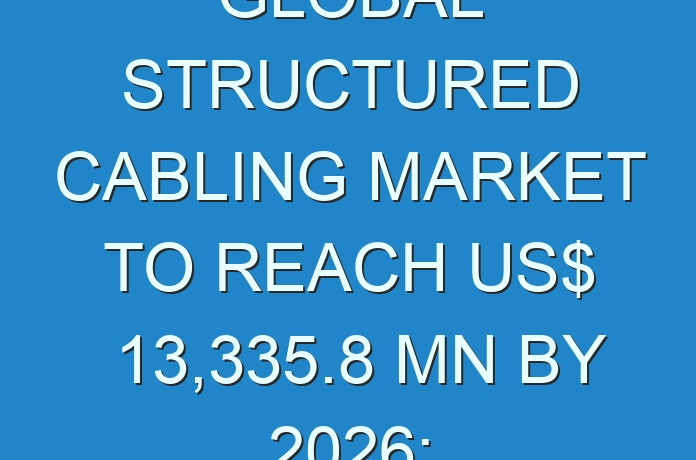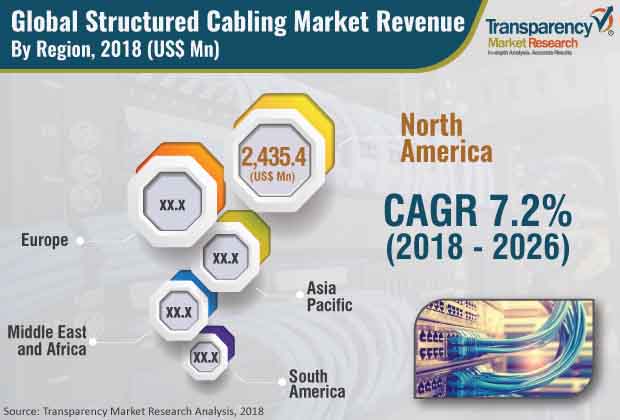
The global structured cabling market was valued at US$ 7,172.5 Mn in 2017 and is anticipated to register a stable CAGR of 7.2% during the forecast period, according to a new report published by Transparency Market Research (TMR) titled ‘Structured Cabling Market – Global Industry Analysis, Size, Share, Growth, Trends, and Forecast, 2018–2026.’ Increasing demand for high bandwidth and expansion and modernization of communication infrastructure fueled by economic growth have driven the global structured cabling market. The market in North America is expanding at the maximum CAGR of 7.1%, owing to technological innovations and presence of a large number of players in the region.
Want to know the obstructions to your company’s growth in future? Request a brochure @ https://www.transparencymarketresearch.com/sample/sample.php?flag=S&rep_id=6823

Hardware segment to drive the structured cabling market
Expanding cable network fueled by rise in modernization of infrastructure in developing economies is resulting in high demand for structured cabling worldwide. Copper cable is the most common cable used in structured networking, due to its lower costs compared to optical fiber. Copper cables are employed in power generation, power transmission, power distribution, telecommunications, electronics circuitry, and numerous electric equipment. Copper has the maximum electric conductivity rating among all non-precious metals. This boosts the demand for copper cables across the globe. The hardware sector has witnessed strong growth, due to continuous installation of a large number of machines and assembly units across the world, followed by extensive channels of wiring systems. This is expected to continue to augment the demand for structured cabling during the forecast period.
Rise in modernizing of communication infrastructure in IT & telecommunication industry to drive the market
Based on end-user, the global structured cabling market has been segmented into commercial & residential, IT & telecommunication, government, industrial, and others (including mining and education). IT & telecommunication is anticipated to be the rapidly expanding end-user segment during the forecast period, followed by the industrial segment. The IT & telecommunication segment is expected to dominate the global market for structured cabling, expanding at the maximum CAGR of 7.3% throughout the forecast period. This is attributable to rising need to facilitate rapid communication and optimized energy consumption. Recently, various enterprises have taken initiatives to expand and modernize their communication infrastructure. The industrial end-user segment is anticipated to expand at a significant CAGR during the forecast period, due to increasing penetration of portable computing devices and rising dependency of multiple industrial sectors on cloud applications.
Furthermore, increasing focus on IoT (Internet of Things) applications is anticipated to fuel the demand for high-bandwidth telecommunication infrastructure in the IT & telecommunication industry in the next few years. This, in turn, is anticipated to fuel the structured cabling market during the forecast period.
Economic growth in the U.S., China, India, and South Africa to create lucrative opportunities
Geographically, the global structured cabling market has been divided into five major regions. These include North America, Europe, Asia Pacific, South America, and Middle East & Africa. In 2017, North America was the leading region of the global market, followed by Europe. Demand for structured cabling is the maximum in North America, due to growth of the IT & telecom industry in the region. The large number of wire and cable shipments to electric utilities in the region is boosting the structured cabling market in North America. Furthermore, the U.S. Government has commissioned several studies to explore methods for upgrading the existing infrastructure. The U.S. held a leading share of the North America market in 2017. The market in the country is estimated to expand at the maximum CAGR during the forecast period. The structured cabling market in Europe is anticipated to expand at a significant CAGR during the forecast period, due to advancements in the field of logistics & transportation in the region. The structured cabling market in Asia Pacific is expected to expand at the maximum CAGR of 7.9% during the forecast period. Rapid growth of the IT industry in Asia Pacific has had a significant positive impact on the demand for mechanical cable accessories in the region. In addition, rapid pace of urbanization and growth of public, private, and residential sectors in Asia Pacific are leading to increasing construction of residential and commercial buildings and new power transmission lines in the region. This, in turn, is boosting the demand for structured cabling in the region. Rapid industrialization in developing countries of the region drives the demand for structured cabling for use in industrial machinery in Asia Pacific.
Purchase Premium Research Report @ https://www.transparencymarketresearch.com/checkout.php?rep_id=6823<ype=S
ABB Ltd., The Cabling Company Group, Belden Inc., CommScope, and Corning, Inc. likely to continue to lead the global structured cabling market
The company profiling of key players operating in the global structured cabling market includes company overview, major business strategies adopted, SWOT analysis, and revenues for years from 2015 to 2017. Key players profiled in the report on the global structured cabling market are ABB Ltd., The Cabling Company Group, Belden Inc., CommScope, Corning, Inc., Dätwyler Cabling Solutions AG, Legrand, Nexans, Schneider Electric SE, and TE Connectivity Ltd. Several players are introducing technologically advanced products and entering into partnerships with other players owing to the rising need for infrastructure development.
Read Our Trending Press Release Below: https://www.prnewswire.com/news-releases/increasing-demand-from-semiconductors-to-invite-extensive-growth-for-epi-wafer-market-through-forecast-period-of-2020-2030-301177165.html





